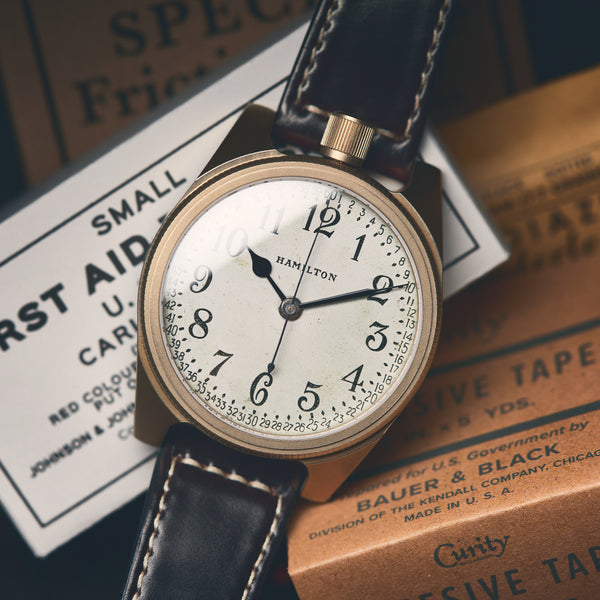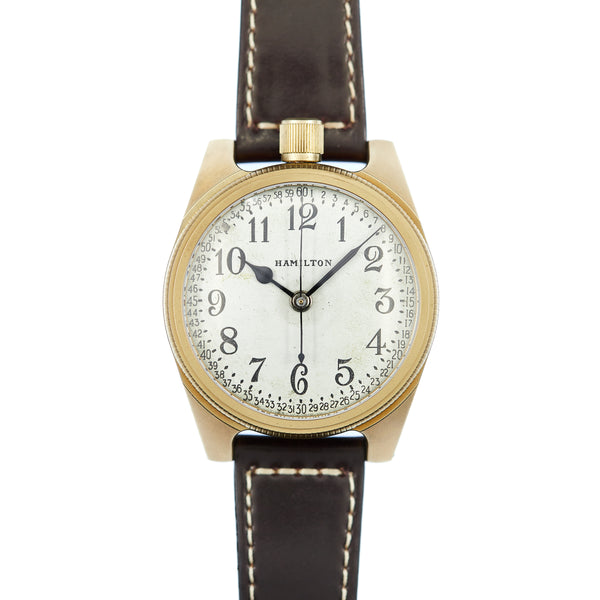Custer & Wolfe Episode #4 Is Live!
Your weekly roundup of now SIX one-of-a-kind watches is below, but first...
Check out episode 4 of Custer & Wolfe, Building a Watch Company on YouTube! In this episode we discuss all the renovations happening to the new building and some of the new machines we have on the way.
This might be a constant reminder now, but...
We're Hiring! Come Work With Us!
We have three, all in-person, positions in our new building in Fort Collins, Colorado, starting soon. Check out our Careers page for the descriptions, and make sure to tell your friends that are on the hunt for a new position too!
If you definitely want to work with us but none of these jobs seem to fit what you need, please email us your resume and we'll discuss!
Here's your Weekly Roundup!
Every Tuesday we send this Weekly Roundup of our most recent Watch of the Day watches. Most watches sell within minutes or hours, so be sure to check the website each day at noon Mountain Time or follow us on social media to get more frequent updates!
We're up to SIX watches per week now!
Click the images of the watches to learn more about them. Make sure to check the website at 12 PM Mountain Time for the Watch of the Day!
Today, we’re pleased to present you this historic, one-of-a-kind piece initially produced by the Elgin National Watch Company in 1911 — the Chicago 471. This early 20th-century watch sports a breathtaking cream-colored dial with a sophisticated floral design in its center. The antique piece also features dark, stylized numerals and vivid blue hour and minute hands, and it also sports a subdial with a matching hand.
We encased the historic pocket watch within our robust and scratch-resistant Machined Titanium case, which draws further attention to the watch’s elegantly-designed dial. On the back of the watch, you can view its breathtaking 347-grade open-face movement, which comes with a Moseley regulator, and a going barrel. The watch also features sumptuous gold-plated gears powered by 17 jewels atop its ¾ plate. We paired this exquisite watch with our artisan-designed Natural leather watch strap along with a gold-plated crown, emphasizing the watch’s distinguished style.
The Elgin National Watch Company originally manufactured this piece in Elgin, Illinois, in 1911 — the same year that the Indianapolis 500 race began. The first race occurred on Decoration Day — now officially called Memorial Day — on May 30. Ray Harroun won the first Indy 500 race with a stylish Marmon automobile, which was an Indianapolis-based car manufacturer. Today, racing fans can view Harroun’s yellow “Wasp” Marmon at the Indianapolis Motor Speedway Museum.
We’re excited to showcase this stunning piece initially produced by the Hamilton Watch Company — the Lancaster 135. The watch sports an antique dial with a distinct circular pattern that matches its dark, stylized numerals. The piece also features violet minute and hour hands that glimmer vividly against the dial’s cream-colored background.
We paired the original pocket watch with our robust and scratch-resistant Machined Titanium case that draws further attention to the piece’s historic and sophisticated dial, and we topped the front of the watch off with a nickel-plated crown that matches the dial’s cream background. Our Machined Titanium’s clear back reveals a 912-grade open-face movement with a nickel finish, black inlay, and pendant setting. You can also view the watch’s intricate inner workings, including its splendid gold-plated gears powered by 17 luxurious jewels. The watch also sports a ¾ plate and a Reed regulator. We tied the piece together with our highly comfortable and stylish Stout leather watch strap, further emphasizing the watch’s simple yet elegant style.
The Hamilton Watch Company originally manufactured this piece in Lancaster, Pennsylvania, in 1926 — the same year that the United States created the U.S. Army Air Corps (USAAC). The USAAC served as part of the United States Army from 1926 to 1941 due to the growing emphasis on aerial warfare. The USAAC became the United States Army Air Forces (USAAF) in 1941, giving it a greater degree of autonomy from the U.S. Army, but it remained part of the army until 1947. In 1947, Congress disbanded the USAAF and created the United States Department of the Air Force.
We’re pleased to showcase this exquisite piece initially manufactured by the Illinois Watch Company in 1922 — the Springfield 491. The watch sports an antique dial with splendid golden details. The dial boasts gold-colored minute and hour hands that match its stylized golden numerals, and the dial also features golden circles along its outer edge. We paired the pocket watch with our PVD Zircon Gold case and equipped it with a gold-plated crown.
Our PVD Zircon Gold case features an open back that reveals the watch’s impressive inner workings. The watch boasts a 405-grade open-face movement with a center bridge plate, bronze-plated gears, and 17 jewels. The watch’s back also features a breathtaking inlaid engraving that reads “The Autocrat,” which is a fitting description for this luxurious, one-of-a-kind piece. To top it off, we equipped the watch with our stylish Cordovan Oxblood leather watch strap, which pairs perfectly with the watch’s golden features.
The Illinois Watch Company originally produced this piece in Springfield, Illinois, in 1922 — the same year that the Lincoln Memorial was dedicated in Washington D.C.’s National Mall. Congress introduced the bill approving the memorial’s construction in 1910, and President William H. Taft served as the head of the Lincoln Memorial Commission. The memorial’s designer, Henry Bacon, stylized the building after a Greek Doric temple, and builders crafted the memorial’s exterior out of Yule Marble from the West Elk Mountains of Colorado.
We’re thrilled to present you this highly rare, antique watch originally manufactured by the Elgin National Watch Company in the late 19th century — the Chicago 474. Elgin only produced 3,000 of these breathtaking pocket watches, and its original run quantity was only 1,000 models. The watch sports a pristine white background with unique, stylized numerals that showcase the watch’s sophisticated design. The dial also features navy hour and minute hands and a subtle, gold-colored pattern underneath its distinct numerals.
We emphasized the watch’s elegant design by encasing it in our glimmering, scratch-resistant Machined Titanium case, and we equipped it with a luxurious-looking gold-plated crown. The back of the watch features stunning, stylized engravings that convey the watch’s historic manufacturer, the Elgin National Watch Company. You can also view the watch’s 194-grade open-face movement with a jeweled safety barrel, golden center wheel, and bronze-plated gears.
Finally, the watch boasts 23 sumptuous ruby jewels with gold settings atop its ¾ plate. We paired the watch with our comfortable, artisan-designed navy leather watch strap. The Elgin National Watch Company initially produced this piece in Elgin, Illinois, in 1898 — the same year the Spanish-American War occurred. The war only lasted from April 21 to August 13, 1898. The war’s conclusion with an American victory marked the end of Spanish colonialism in North and South America.
We’re pleased to present this pristine, elegant watch originally manufactured by the Hampden Pocket Watch Company in 1915 — the Canton 018. The piece’s dial exudes sophistication with its striking dark Roman numerals that contrast its white background. The watch’s blue-tinted hour and minute hands emphasize the dial’s distinguished style. We encased the original pocket watch in our robust, scratch-resistant Machined Titanium case.
The shimmering case draws further attention to the dial’s refined sophistication. We also added rustic colors to the final piece by equipping the watch with a copper-colored crown and Natural leather watch strap. The back of the watch boasts a Biltmore-grade open-face movement with nickel finish, pendant setting, and patent regulator. The watch also sports 17 luxuriously vivid jewels atop its bridge plate and gold-plated gears.
The Hampden Watch Company initially produced the pocket watch in Canton, Ohio, in 1915 — the same year that Alexander Graham Bell made the famous “first transcontinental telephone call” from New York City to San Francisco during the Panama-Pacific International Exposition. In reality, this was not the first transcontinental phone call, but Bell and the American Telephone and Telegraph Company (AT&T) claimed it was for marketing purposes. On the call, Bell repeated his famous line from 1876, “Mr. Watson, come here; I want you.” The call officially launched AT&T’s transcontinental service.
We’re thrilled to present you this elegant piece initially produced by the Hamilton Pocket Watch Company in 1928 — the Lancaster 134. The piece’s simple yet stylish dial features a white background along with subtle, highly unique dots along its face. The dial also sports navy hour and minute hands with arrow-shaped tips as well as dark, stylish numerals that convey the watch’s antique qualities.
We paired the original pocket watch with our robust, one-of-a-kind Machined Titanium case, and we topped it off with a copper crown. The Machined Titanium’s rear display case reveals breathtaking details, including 19 ruby jewels with gold settings, a ¾ plate, a micrometer regulator, and a Breguet hairspring. The piece also boasts gold-plated gears that match its distinct gold-colored engravings. Its engravings attest to the watch’s authenticity reading “Hamilton Watch Co. Lancaster, PA.” Finally, the watch’s 918-grade open-face movement comes with a nickel finish and pendant setting. We equipped this antique piece with our comfortable, artisan-designed Olive leather watch strap.
The Hamilton Watch Company manufactured the pocket watch in 1928 — the same year that sliced bread became available to the public. Sliced bread inventor Otto Frederick Rohwedder first created a bread-slicing machine prototype in 1912, but a fire destroyed his invention. Fortunately, in 1928, Fohwedder successfully developed a fully working bread-slicing machine. The Missouri-based Chillicothe Baking Company sold the first bread slices on July 7, 1928, meaning the Lancaster 134 is as old as sliced bread.





























